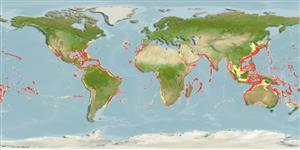Common names from other countries
>
Scombriformes (Mackerels) >
Gempylidae (Snake mackerels)
Etymology: Diplospinus: Greek, diploos = twice + Latin, spina = spine, thorn (Ref. 45335).
Environment: milieu / climate zone / depth range / distribution range
ນິເວດວິທະຍາ
ສັດທະເລ ກ່ຽວກັບ (ຢູ່)ເທິງຊັ້ນພື້ນດິນໃນທະເລເປີດ; ລະດັບຄວາມເລິກ 50 - 1000 m (Ref. 9784). Deep-water; 42°N - 38°S, 180°W - 180°E
Atlantic, Indian and Pacific: in central water masses. Rather rare, but relatively abundant in the northwest and southeast Atlantic and southeast Pacific Ref. 6181).
Length at first maturity / ຂະໜາດ / ນ້ຳໜັກ / Age
Maturity: Lm ?, range 16 - ? cm
Max length : 33.0 cm SL ຕົວຜູ້/ບໍ່ມີເພດ; (Ref. 9784); common length : 20.0 cm SL ຕົວຜູ້/ບໍ່ມີເພດ; (Ref. 6181)
ຄີ (ໜາມ)ແຂງຢູ່ຫຼັງປາ (ທັງໝົດ) : 30 - 36; ຄີຫຼັງຂອງປາ (ຄີອ່ອນ) (ທັງໝົດ) : 35 - 44; ຄີ(ໜາມ) ແຂງຢູ່ຄີກົ້ນປາ
ກຸ່ມປາກະດູກແຂງ
ຄວາມຖີ່ຂອງກຸ່ມຖ່າຍທອດພັນ
ປາທີ່ມີການເຄື່ອນຍ້າຍຈາກທະເລໄປຫານ້ຳຈືດ ແລະນ້ຳຈືດຫາທະເລ
ປາທີ່ມີການເຄື່ອນຍ້າຍຈາກທະເລແລະໄປໄຂ່ຢູ່ນ້ຳຈືດ
ຄີກົ້ນຂອງປາ
ສັດທີ່ມີກະດູກສັນຫັຼງ
ການຖ່າຍທອດທາງກຳມະພັນຈາກພໍ່ແມ່ຫາລູກ: 2; ຄີກົ້ນຂອງປາ: 28 - 35; ສັດທີ່ມີກະດູກສັນຫຼັງ: 57 - 64. Body is extremely elongate and compressed. Lower jaw extends anterior to upper jaw with a small conical dermal process. Upper jaw with 3 immovable and 3 or 4 movable fang-like teeth anteriorly. Lateral line situated closer to the ventral profile than the dorsal profile posteriorly. Color is silvery with narrow dark dotted lines along the body; the gill membranes are jet-black.
Oceanic, migrating upward at night to 100 to 200 m (Ref. 6181). Probably forming schools during daytime (Ref. 6181). Feed on crustaceans and small fish (Ref. 6181). Females mature at about 16 cm (Ref. 36731). Eggs and larvae are pelagic (Ref. 6766).
Nakamura, I. and N.V. Parin, 1993. FAO Species Catalogue. Vol. 15. Snake mackerels and cutlassfishes of the world (families Gempylidae and Trichiuridae). An annotated and illustrated catalogue of the snake mackerels, snoeks, escolars, gemfishes, sackfishes, domine, oilfish, cutlassfishes,. scabbardfishes, hairtails, and frostfishes known to date. FAO Fish. Synop. 125(15):136 p. (Ref. 6181)
IUCN Red List Status (Ref. 130435)
CITES (Ref. 128078)
Not Evaluated
Threat to humans
Harmless
Human uses
ການປະມົງ: ການປະມົງແບບກຸ້ມຕົນເອງ
ເຄື່ອງມື
Special reports
Download XML
ແຫຼ່ງອີນເຕີເນັດ
Estimates based on models
Preferred temperature (Ref.
115969): 8.7 - 19.2, mean 13.1 (based on 808 cells).
Phylogenetic diversity index (Ref.
82804): PD
50 = 1.0000 [Uniqueness, from 0.5 = low to 2.0 = high].
Bayesian length-weight: a=0.00363 (0.00163 - 0.00807), b=3.10 (2.91 - 3.29), in cm Total Length, based on LWR estimates for this (Sub)family-body shape (Ref.
93245).
ຊັ້ນເຂດຮ້ອນ (Ref.
69278): 3.5 ±0.52 se; based on food items.
ຄວາມຢືດຢຸ່ນ (Ref.
120179): ຂະໜາດກາງ, ປະຊາກອນຕຳ່ສຸດທີ່ໃຊ້ເວລາສອງເທົ່າ 1.4 - 4.4 ປີ (Fec=1,200).
Fishing Vulnerability (Ref.
59153): Low to moderate vulnerability (30 of 100).
